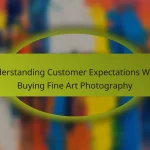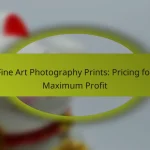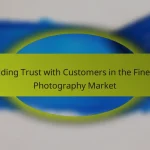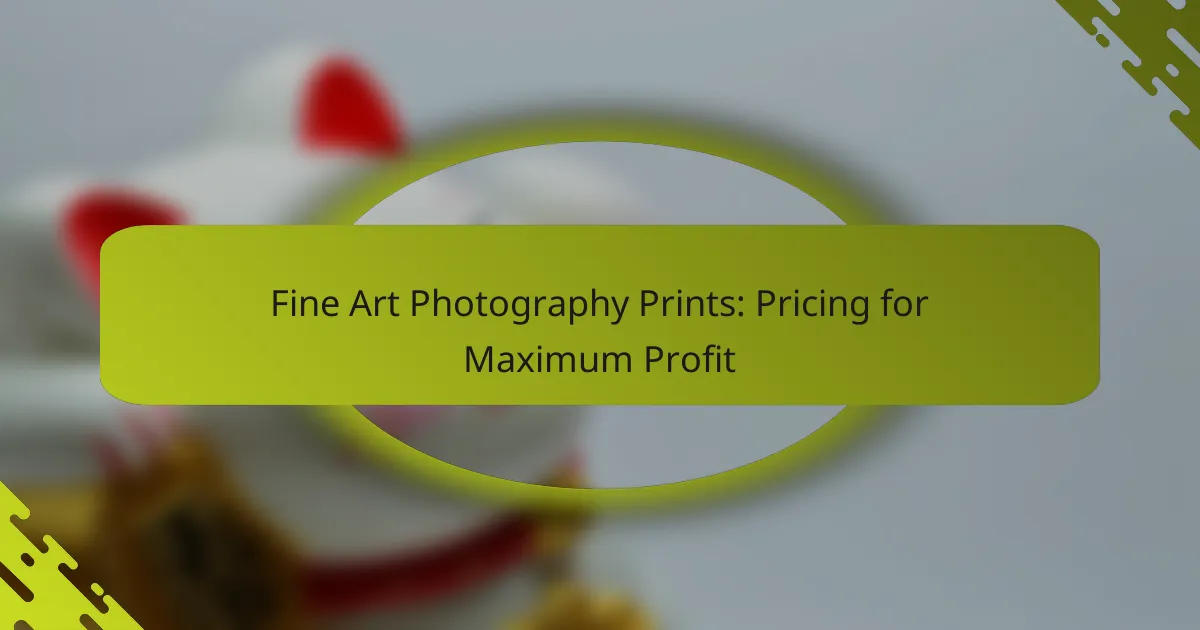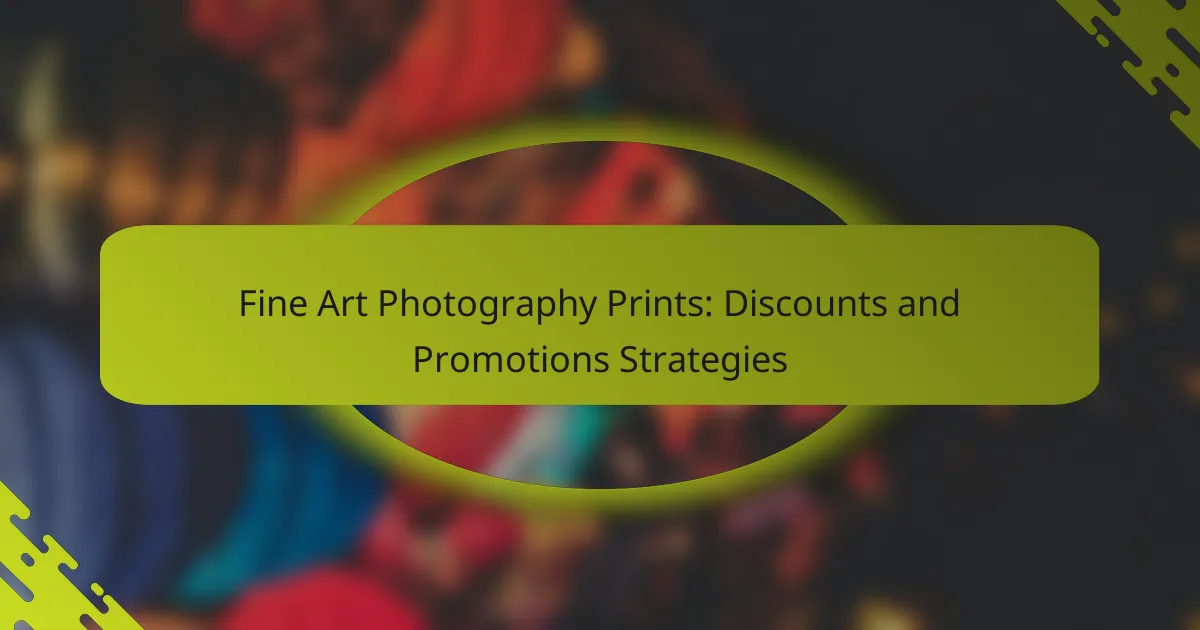Pricing fine art photography prints effectively is crucial for maximizing profit while remaining competitive in the market. By integrating cost-based, value-based, and market-based strategies, photographers can navigate the complexities of pricing influenced by production costs, market demand, and their own reputation. Selecting the right sales platform, such as Etsy or Saatchi Art, further enhances the potential for profitability by targeting the appropriate audience.

How to price fine art photography prints for maximum profit?
To price fine art photography prints for maximum profit, consider a blend of cost-based, value-based, and market-based strategies. Each approach offers unique insights that can help you set competitive prices while ensuring profitability.
Cost-based pricing strategy
A cost-based pricing strategy involves calculating the total costs of producing your prints and adding a markup for profit. Start by determining your fixed costs, such as equipment, studio space, and marketing, along with variable costs like printing and shipping.
For example, if your total costs amount to $50 per print and you want a profit margin of 50%, you would price each print at $75. This method ensures that all expenses are covered while providing a clear profit margin.
Value-based pricing strategy
Value-based pricing focuses on the perceived value of your artwork to customers rather than just the costs incurred. This strategy requires understanding what your audience is willing to pay based on the emotional and aesthetic value they derive from your prints.
For instance, if your photography evokes strong emotions or is part of a limited edition, you might price your prints significantly higher than the cost-based price. Researching similar artists and their pricing can help you gauge the value of your work in the market.
Market-based pricing strategy
A market-based pricing strategy involves analyzing the prices of similar fine art photography prints in your niche. This approach helps you position your work competitively while considering factors like demand and market trends.
To implement this strategy, survey online galleries, art fairs, and local exhibitions to see how other photographers price their prints. Adjust your prices accordingly, ensuring they reflect your unique style and quality while remaining attractive to potential buyers.

What factors influence pricing of fine art photography prints?
The pricing of fine art photography prints is influenced by several key factors, including production costs, market demand, and the artist’s reputation. Understanding these elements can help photographers set competitive prices that maximize their profits.
Production costs
Production costs encompass all expenses related to creating and selling fine art photography prints. This includes costs for materials such as high-quality paper, ink, and framing, as well as overhead expenses like studio rent and equipment maintenance.
To effectively price prints, artists should calculate their total production costs and consider adding a markup for profit. A common approach is to aim for a markup of 50-100% over costs, depending on the market and competition.
Market demand
Market demand plays a crucial role in determining the price of fine art photography prints. If there is high demand for a particular style or subject, artists can command higher prices. Conversely, oversaturated markets may require lower pricing to attract buyers.
Artists should research current trends and analyze sales data to gauge demand. Engaging with potential customers through social media or art fairs can provide insights into what buyers are willing to pay.
Artist reputation
The reputation of the artist significantly impacts the pricing of their fine art photography prints. Established artists with a strong portfolio and recognition in the art community can often charge premium prices, while emerging artists may need to start with lower prices to build their brand.
To enhance reputation, artists should focus on networking, participating in exhibitions, and promoting their work online. Consistent quality and unique artistic vision can help elevate an artist’s standing and justify higher prices over time.
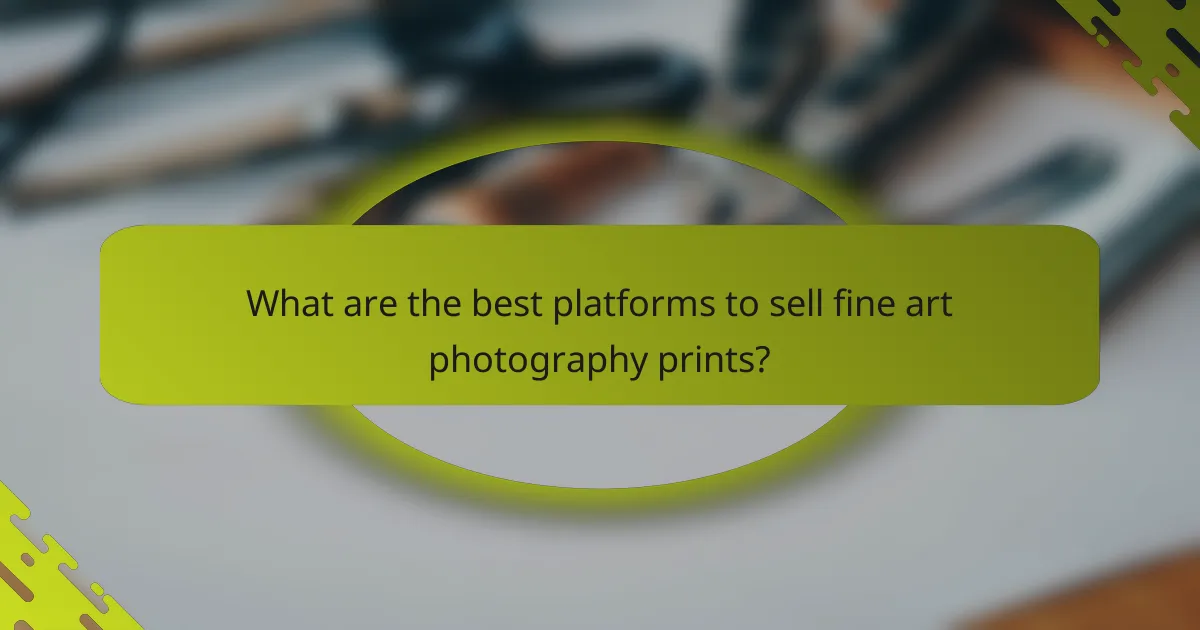
What are the best platforms to sell fine art photography prints?
The best platforms for selling fine art photography prints include Etsy, Saatchi Art, and Fine Art America. Each platform has unique features that cater to different audiences and pricing strategies, making it essential to choose the right one for your artwork.
Etsy
Etsy is a popular marketplace for handmade and vintage items, including fine art photography prints. It allows artists to set up their own shops and directly engage with customers, which can enhance sales through personal connections.
When selling on Etsy, consider the listing fees and transaction costs, which can impact your profit margins. Pricing your prints competitively while accounting for these fees is crucial. Many artists find success by offering limited editions or unique sizes to attract buyers.
Saatchi Art
Saatchi Art is a global online art gallery that specializes in original artwork and limited edition prints. This platform provides artists with exposure to a wider audience and handles shipping, making it easier for sellers.
Artists should be aware that Saatchi Art takes a commission on sales, typically around 35%. To maximize profit, consider pricing your prints to reflect this commission while ensuring they remain attractive to potential buyers. The platform also offers promotional opportunities that can help increase visibility.
Fine Art America
Fine Art America is a dedicated platform for artists to sell prints and other products featuring their artwork. It offers a range of print options, including canvas and framed prints, which can appeal to different customer preferences.
One advantage of Fine Art America is its print-on-demand service, which eliminates the need for upfront inventory costs. However, artists should keep in mind the base pricing set by the platform when determining their selling prices. Setting competitive prices while ensuring a reasonable profit margin is key to success on this platform.
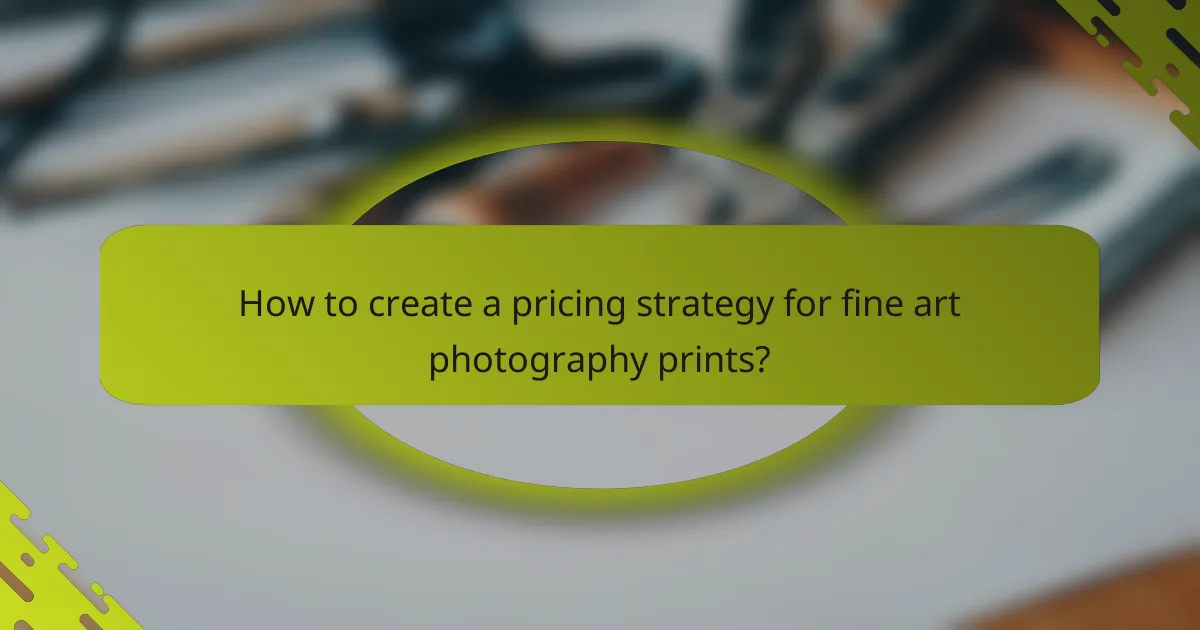
How to create a pricing strategy for fine art photography prints?
Creating a pricing strategy for fine art photography prints involves understanding your market, identifying your audience, and setting competitive yet profitable prices. This approach ensures that your pricing reflects the value of your work while appealing to potential buyers.
Identify target audience
To effectively price your fine art photography prints, first identify your target audience. Consider factors such as demographics, interests, and purchasing behavior. For instance, art collectors may be willing to pay more for limited editions, while casual buyers might prefer more affordable options.
Engage with your audience through social media or art shows to gather insights on their preferences and spending habits. This information will help you tailor your pricing strategy to meet their expectations and maximize sales.
Analyze competitors
Research your competitors to understand their pricing strategies for similar fine art photography prints. Look at artists with a comparable style and reputation, and note their price ranges. This analysis will provide a benchmark for your own pricing and help you position your work effectively.
Pay attention to how competitors market their prints, including any unique selling points they emphasize. This can inform your own marketing efforts and highlight aspects of your work that justify your pricing.
Set pricing tiers
Establishing pricing tiers can help cater to different segments of your audience. Consider offering a range of options, such as limited edition prints at a higher price point and open edition prints at a more accessible price. This strategy allows you to attract both serious collectors and casual buyers.
When setting your tiers, factor in production costs, desired profit margins, and perceived value. For example, limited editions could be priced significantly higher, perhaps in the hundreds or thousands of dollars, while open editions might range from the low tens to a few hundred dollars. This tiered approach can enhance your overall sales and profitability.

What are the common mistakes in pricing fine art photography prints?
Common mistakes in pricing fine art photography prints include underpricing artwork, ignoring market trends, and neglecting production costs. These errors can significantly affect profitability and the perceived value of the work.
Underpricing artwork
Underpricing artwork is a frequent mistake that can undermine an artist’s credibility and profitability. Many photographers set prices too low in an attempt to attract buyers, which can lead to a devaluation of their work in the long run.
To avoid this pitfall, research comparable artists and their pricing strategies. Consider factors such as your experience, the uniqueness of your work, and the quality of your prints. A good rule of thumb is to price prints based on a multiple of your production costs, often ranging from two to five times the cost.
Ignoring market trends
Ignoring market trends can result in pricing that is out of sync with current demand. Fine art photography is influenced by various factors, including seasonal trends, popular themes, and emerging styles.
Stay informed about the art market by following industry news, attending exhibitions, and engaging with other artists. Adjust your pricing periodically to reflect shifts in demand and to ensure your work remains competitive.
Neglecting production costs
Neglecting production costs is a critical error that can erode profit margins. Many photographers overlook expenses such as printing, framing, shipping, and marketing when setting prices.
To ensure profitability, create a detailed breakdown of all production costs and incorporate these into your pricing strategy. Consider using a simple formula: total production costs multiplied by a markup percentage that reflects your desired profit margin. This approach helps maintain financial sustainability while valuing your artistic efforts appropriately.

How to leverage social media for selling fine art photography prints?
Utilizing social media effectively can significantly boost sales of fine art photography prints. Platforms like Instagram and Facebook allow artists to showcase their work, engage with potential buyers, and create targeted advertising campaigns.
Instagram marketing
Instagram is a visual platform ideal for promoting fine art photography. Use high-quality images of your prints, along with engaging captions that tell the story behind each piece. Regularly posting and utilizing features like Stories and Reels can enhance visibility.
Consider using relevant hashtags to reach a broader audience, such as #FineArtPhotography or #ArtForSale. Engaging with followers through comments and direct messages can also foster a loyal customer base.
Facebook ads
Facebook ads offer targeted advertising options that can help you reach specific demographics interested in fine art. You can create ads that showcase your photography prints, directing users to your online store or website.
Set a budget that aligns with your marketing goals, starting with a modest amount to test ad performance. Monitor the results and adjust your strategy based on which ads generate the most engagement and sales.
Influencer partnerships
Collaborating with influencers who align with your artistic vision can expand your reach. Look for influencers in the art or photography niche who have a following that matches your target market.
Offer them a print in exchange for a review or feature on their social media. This can introduce your work to new audiences and lend credibility to your brand, potentially leading to increased sales.


